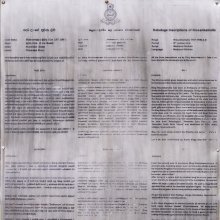Gosh, Goṣ: 2 definitions
Introduction:
Gosh means something in Hinduism, Sanskrit, biology. If you want to know the exact meaning, history, etymology or English translation of this term then check out the descriptions on this page. Add your comment or reference to a book if you want to contribute to this summary article.
The Sanskrit term Goṣ can be transliterated into English as Gos or Gosh, using the IAST transliteration scheme (?).
Images (photo gallery)
Biology (plants and animals)
Source: Google Books: CRC World Dictionary (Regional names)Gos in Namibia is the name of a plant defined with Acacia reficiens in various botanical sources. This page contains potential references in Ayurveda, modern medicine, and other folk traditions or local practices It has the synonym Acacia uncinata Engl.) (the specific and subspecific names from the Latin reficio, ficere, feci, fectum (facio) ‘to make again, to restore, to repair’.
Example references for further research on medicinal uses or toxicity (see latin names for full list):
· Bothalia (1981)
· Bothalia (1974)
· Sitzungsberichte der Mathematisch-Physikalischen Classe (Klasse) der K. B. Akademie der Wissenschaften zu München (1860)
If you are looking for specific details regarding Gos, for example diet and recipes, pregnancy safety, extract dosage, chemical composition, health benefits, side effects, have a look at these references.

This sections includes definitions from the five kingdoms of living things: Animals, Plants, Fungi, Protists and Monera. It will include both the official binomial nomenclature (scientific names usually in Latin) as well as regional spellings and variants.
Languages of India and abroad
Sanskrit dictionary
Source: Cologne Digital Sanskrit Dictionaries: Monier-Williams Sanskrit-English DictionaryGoṣ (गोष्):—[from go] (idem)
Sanskrit, also spelled संस्कृतम् (saṃskṛtam), is an ancient language of India commonly seen as the grandmother of the Indo-European language family (even English!). Closely allied with Prakrit and Pali, Sanskrit is more exhaustive in both grammar and terms and has the most extensive collection of literature in the world, greatly surpassing its sister-languages Greek and Latin.
See also (Relevant definitions)
Starts with (+117): Gosava, Gosha, Goshad, Goshada, Goshadadi, Goshadaka, Goshadangavidhi, Goshadgava, Goshadi, Goshaka, Goshakata, Goshakhi, Goshakridrasa, Goshakrinmutramahatmya, Goshakrit, Goshala, Goshale, Goshali, Goshalikaputra, Goshalin.
Ends with: Marzangosh, Neel-gosh, Nil-gosh, Petigosh.
Full-text (+35): Goshpada, Goshpadatriratravrata, Goshpadatritiyavrata, Goshpadamatra, Gotpada, Goshpadapram, Goshpadapuram, Mashaallaha, Gos el-hinf, Daiya, Gor, Neel-gosh, Nil-gosh, Civarika, Canah, Dhat, Guhyasamajatantra, Oddiyana, Karitra, Vidarbhayati.
Relevant text
Search found 20 books and stories containing Gosh, Goṣ, Gos; (plurals include: Goshes, Goṣs, Goses). You can also click to the full overview containing English textual excerpts. Below are direct links for the most relevant articles:
Sahitya-kaumudi by Baladeva Vidyabhushana (by Gaurapada Dāsa)
Text 7.136 < [Chapter 7 - Literary Faults]
Text 10.234 < [Chapter 10 - Ornaments of Meaning]
Text 4.56 < [Chapter 4 - First-rate Poetry]
A Manual of Khshnoom (by Phiroz Nasarvanji Tavaria)
Trishashti Shalaka Purusha Caritra (by Helen M. Johnson)
Thirty-six weapons < [Notes]
Part 29: The people in the Manuṣyaloka < [Chapter III - The initiation and omniscience of Ajita]
Blue Annals (deb-ther sngon-po) (by George N. Roerich)
Chapter 9 - The Tibetan emperors prophesied in the Mūlatantra < [Book 1 - The beginning of the story of the Doctrine]
Chapter 2 - Guhyasamāja-tantra system of Noble Nāgārjuna < [Book 7 - The preaching of the Tantras]
Chapter 9 - The third Kālacakra lineage < [Book 10 - The Kālacakra]
Guhyagarbha Tantra (with Commentary) (by Gyurme Dorje)
Text 3.8 (Commentary) < [Chapter 3 (text and commentary)]
6. Origin of the Guhyagarbhatattvaviniścayamahātantra < [Introduction]
Text 17.6 (Commentary) < [Chapter 17 (Text And Commentary)]
Tibet (Myth, Religion and History) (by Tsewang Gyalpo Arya)
2. Genesis; the Tibetan Calendar < [Chapter 4 - King Srongtsan Gampo and His Period]
5. Conclusion < [Chapter 4 - King Srongtsan Gampo and His Period]
3. Probability Analysis < [Chapter 4 - King Srongtsan Gampo and His Period]
